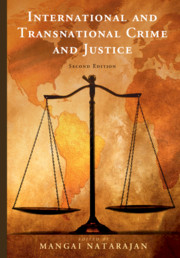Book contents
- International and Transnational Crime and Justice
- International and Transnational Crime and Justice
- Copyright page
- Contents
- Figures and Tables
- Preface
- About the Editor
- Notes on Contributors
- Introduction
- PART I OVERVIEW: TRANSNATIONAL CRIME
- PART IA Varieties of Transnational Crimes
- PART IB Transnational Organized Crime
- PART IC Factors that Facilitate Transnational Crimes
- PART ID Transnational Justice Matters
- PART II OVERVIEW: INTERNATIONAL CRIME
- PART III OVERVIEW: INTERNATIONAL AND TRANSNATIONAL CRIME RESEARCH
- World Map
- Index
- References
PART IB - Transnational Organized Crime
from PART I - OVERVIEW: TRANSNATIONAL CRIME
Published online by Cambridge University Press: 20 June 2019
- International and Transnational Crime and Justice
- International and Transnational Crime and Justice
- Copyright page
- Contents
- Figures and Tables
- Preface
- About the Editor
- Notes on Contributors
- Introduction
- PART I OVERVIEW: TRANSNATIONAL CRIME
- PART IA Varieties of Transnational Crimes
- PART IB Transnational Organized Crime
- PART IC Factors that Facilitate Transnational Crimes
- PART ID Transnational Justice Matters
- PART II OVERVIEW: INTERNATIONAL CRIME
- PART III OVERVIEW: INTERNATIONAL AND TRANSNATIONAL CRIME RESEARCH
- World Map
- Index
- References
- Type
- Chapter
- Information
- International and Transnational Crime and Justice , pp. 161 - 162Publisher: Cambridge University PressPrint publication year: 2019
References
REFERENCES
REFERENCES
REFERENCES
REFERENCES
REFERENCES
REFERENCES
REFERENCES
WEBSITES
Balkan Investigative Reporting Network. www.birn.eu.com.
Center for the Study of Democracy. www.csd.bg.
RiskMonitor. www.riskmonitor.bg.



